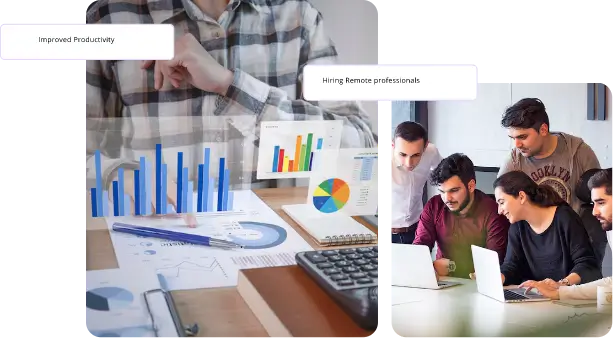What is a Group Meeting? Benefits, Components, How to Conduct & Manage?
A group meeting is an organized event where a team gathers to discuss goals, provide updates, stimulate thinking, and make decisions together. Whether in-person or virtual, group meetings are key elements to helping maintain alignment around the responsibilities of a team or organization. From project updates and performance reviews to problem-solving sessions, group meetings offer a dedicated space for meaningful interaction and team growth.
In modern work environments, managing group meetings strategically is essential. Group meetings promote collaboration, communication, decision-making, and motivation to work together in a meaningful way. When a group meeting has a clear agenda and intentions for roles and participation by all members, you are much more likely to have everyone (plus their information, and plan) in alignment. The effective management of group meetings includes defining intended outcomes, discovering digital collaboration tools, and reviewing whether intended outcomes are met.
What is a Group Meeting?
Group meeting is a type of activity that occurs when the team members put their ideas or thoughts together and discussion takes place about the team project as a whole. In group meetings the team members can collaborate in making decisions, track progress toward completion, and brainstorm solutions to challenges. Such meetings foster open communication, strengthen teamwork, and help ensure that project objectives are met efficiently.
Group meeting purpose is to align individual efforts with the team goals and to make sure that all team members are on the same page. Group meetings allow for effective communication to be maintained, allow for sharing of ideas, and allows the team to make timely decisions on moving the project forward.
Group meetings are a necessary part of team project work so that team members are able to track their progress, stay on track with their goals/objectives, stay aligned, engage in collaboration, and promote problem-solving. Group meetings allow for the team to share concerns and queries, promote collaboration with other team members, and allow for problem-solving.
Additionally, group meetings enhance transparency in workflow and build stronger interpersonal relationships within the team. They contribute to better time management and more efficient project execution.
What are the Types of Group Meetings?
There are various types of group meetings based on purpose and structure:
- Project Kick-off Meeting: This meeting helps everyone understand the project’s purpose, their role, and what’s expected from the start. It sets the tone for smooth teamwork and a shared vision.
- Progress Sync: A quick check-in to see how things are going, solve any issues, and make sure everyone’s moving in the right direction.
- Strategy Alignment Meeting: A chance to pause, see what’s working (or not), and realign our goals for the next month or quarter. It helps to stay focused on what really matters.
- Project Retrospective Meeting: It reflects on finished projects to celebrate wins and talk honestly about what could be better. It’s all about learning and growing as a team.
- New Hire Orientation: This gives new team members a warm welcome, helping them understand their role, meet the team, and get off to a strong start.
- Vision & Planning Meeting: Once a year, we step back to look at the big picture, adjust our direction if needed, and plan where we’re heading next.
How to Conduct an Effective Group Meeting?

- Clarify Purpose: Be clear about the intended purpose of the meeting - a shared purpose helps keep focus and purpose for all.
- Invite Carefully: Only include people who are relevant to the topic at hand - the more people involved, the harder it is to have a discussion.
- Share Agenda Ahead of Time: Send out a simple agenda a day or two ahead of the meeting so everyone is clear on what to expect.
- Prepare Materials: Have slides, reports, visuals or anything else you might want to refer to or help to reduce boredom.
- Start With Intent: Set the tone or apologize for the informal start and reiterate the purpose and agenda to link everyone in.
- Encourage Voices: Ensure that all voices are heard and valued, as opposed to just the people who voice their opinions loudly when asked.
- Keep the Discussion on Purpose: Help to keep the meeting focussed and purposeful. Pay attention to time and encourage clear diversions to steer clear of irrelevant topics during the meeting.
- Clearly Wrap Up: Summarize key decisions or actions and who have been assigned these tasks, so everyone leaves with a clear sense of next steps.
What Are Some Challenges in Group Meetings?
- Lack of Clear Agenda and Objectives: Without a clear agenda, meetings can derail or waste time. This also creates confusion and lack of efficiency.
- Dominating voices: Sometimes, one or two voices can take over the conversation limiting the input from other group members. This limits collaboration by not allowing diverse ideas from team members to take hold.
- Poor Time Management: Meetings that run too long or go off agenda can disengage team members. Important items can either be rushed through the discussion or omitted altogether.
- Low Engagement: Not everyone feels comfortable expressing their views, particularly in larger groups. This is especially detrimental when team members have innovative ideas to share.
- Too Many Meetings: Repeated meetings especially when they are unnecessary create meeting fatigue. This fatigue reduces your enthusiasm and overall productivity and engagement as time goes on.
- Lack of Preparation: When team members do not review documents or prepare in advance, it usually leads to minimal discussions and unproductive discussions. This also limits the decision-making process and wastes time.
What Are the Best Practices for Group Meetings?
To make group meetings more productive and meaningful, it’s helpful to follow a few key practices:
- Set the Stage Before Meeting: Let everyone know what to expect by sharing a clear plan ahead of time—what you’ll talk about, the goal of the meeting, and how long each part will take. It helps people come prepared and focused.
- Keep Things on Track: Have someone lead the conversation to gently guide discussions, make sure everyone gets a chance to speak, and avoid going off-topic.
- Respect of Time: Start and wrap up on time. Keeping things short, relevant, and to the point makes the meeting more productive, and appreciated.
- Make Space for Everyone: Encourage everyone to speak up, even the quieter ones. A meeting feels more like a team effort when all voices are heard.
- Wrap Up with Clarity: End with a quick summary of what’s been decided, who’s doing what, and by when. That way, no one leaves confused about next steps.
- Review and Improve: Take time to reflect on how the meeting went and gather feedback to make future meetings smoother and more effective.

